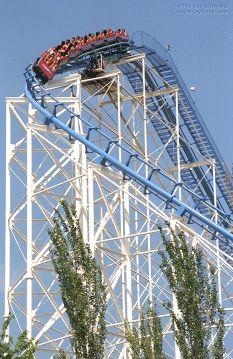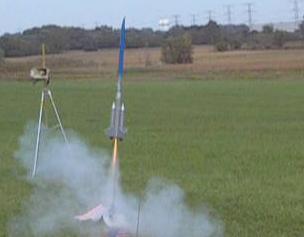Scratch Shockwave (BRS Contest) Original Design / Scratch Built
Scratch - Shockwave (BRS Contest) {Scratch}
Contributed by Jon Revelle
| Manufacturer: | Scratch |

Brief:
I made Shockwave out of some spare parts I had laying around. It is named after
my favorite roller coaster that was just torn down and features a long payload
tube, multiple fins, and side-pods.
Construction:
To make this rocket you need:
- BT-50 (12" long) body tubes, nose cone, and tail cones from an Estes SR-71 kit
- 3 BT-50 body tubes, one 32cm (12") and two 16.5cm (6.4").
- 1 BT-55 body tube 23cm (9") long
- 1 BT-50 to BT-55 transition 3cm (1.1") long
- Shock cord
- 18" Parachute
- 3/16" x 3.5" Launch lug (placed 19cm (17.4") from bottom of BT55)
- Body tube, fins, and tail cone from an Estes Bull Pup 12D kit
- Fin Template (CLICK HERE)
- 1 - Estes PNC-50YR Nose Cone (like Orbital Transport or Echostar)
- 1 D engine motor mount (extended by 1/4" out of the central BT-55)

I started by building the upper half of Shockwave with the long SR-71 body tube, Bullpup canard fins and tail cone, and Echostar/OT nose cone. The tail cone was left unmodified and uncut. The narrow end of the tail cone was inserted into the long BT-50 body tube and glued with plastic cement. Next, I attached the four Bullpup canard fins 3cm from the top of the body tube. Everything was set aside to dry before attaching the shock cord and 18" chute.
The lower half began by attaching the Bullpup fins at the bottom of the rocket. Next, following the SR-71 kit's instructions, I assembled the jet engine sections. Once dry, I attached the jet engine assembly to the Bullpup body tube in between 2 fins. At this point I pause again to let everything have a chance to dry.
The last part of the build was to assemble the D motor mount so it will fit in the body tube. Motor retention is with the engine hook. The shock cord is glued into place by the standard 3-fold paper mount in the body tube.

Finishing:
I started by spray painting the entire rocket the shiniest chrome paint I could find. Then I sprayed half of the payload tube and nose cone midnight blue and then silver without masking the rocket off to create a fade effect that makes it look like it's moving, even when it's on the ground. One of the last things I did was buy some decal paper from Tango Papa and printed the decal shown. This was put on the area where there is light blue. I finished it by clear coating the rocket to protect the decal.
Flight:
I haven't had the chance to fly it yet. But my prediction is that since it uses
D12s, it should go very high, very quickly and that it might drift a bit on the
way down.
Recommended engines are D12-5, D12-7, and E9-6 (if you choose to modify with an E motor mount).
Summary:
PROs: Exotic looking and impressive on and off the pad.
CONS: Not really any.
(Contributed - by Jon Revelle - 03/12/06)
Brief:
Updated version of my entry for the BRS Design Contest. Features new fin design
and new paint job.
Construction:
Shockwave's design was revised after its first flight. The Bullpup fins were
not large enough to provide stable flights (as it lost control on first flight
with Bullpup fins). The fins were changed to Echostar fins, which provide a
MUCH more stable flight.
Changing the fins was easy. All that was needed to be done was remove the old fins, sand down the leftovers and CA the new fins on. Then paint.
Finishing:
Shockwave was 75% repainted after the rehab. The new fins were painted silver
to match the lower body tube section. The upper half (former payload tube) was
changed from Navy Blue and True Blue (I call it Shockwave Blue) to only true
blue. It still has the fade effect and the ride's logo in the same spot.
Rebuilding this rocket was the best decision for this rocket as it now looks better and flies better.
 Flight:
Flight:
The "new" Shockwave flew in April of 2005 at a NIRA club launch. The
rocket used about 5 sheets of wadding and it apparently wasnt enough. It flew
very straight and high on a C11-3, but then the shock cord snapped at ejection.
The booster fell to the ground but the only damage suffered were two fins
popped off. The top part (which is no longer used for payloading) drifted down
on an 18" parachute.
I now use about 7 sheets of wadding in this rocket.
Summary:
These modifications greatly improved Shockwave's performance and looks and now
it is MUCH safer to fly. I have a D12-5 ready to be used in it and then I will
try it on an E9-6.
Other:
ALWAYS Use long shock cords. Short ones snap WAY too easy.
 |
 |